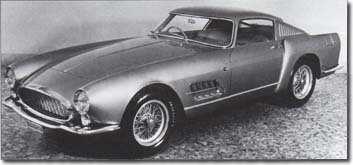

When a new GT racing category was announced for the 1955 season, Enzo Ferrari immediately recognized the potential of hs 250 GT, powered by a development of Colombo's classic V12. John Starkey traces the steps that led to the "Tour de France" model, the first series-built Ferrari GT, and the machine that would spread the Ferrari legend farther and wider than ever before. Rich Chenet captures on film the car we chose to exemplify the "TdF" in its ultimate form: Lance Hill's immaculate s/n 0707.
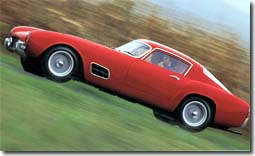 At this time, the 250 GT engine was undergoing a development and tuning process which would last until 1964. In 1955, however, the engine was known by the factory as the Tipo 112 and was very similar to the engine from the 250 Mille Miglia series, but with three twin-choke 36 DCZ3 carburetors fitted instead of the beautiful IFC 4-choke carbs originally used on the 250 Mille Miglia.
At this time, the 250 GT engine was undergoing a development and tuning process which would last until 1964. In 1955, however, the engine was known by the factory as the Tipo 112 and was very similar to the engine from the 250 Mille Miglia series, but with three twin-choke 36 DCZ3 carburetors fitted instead of the beautiful IFC 4-choke carbs originally used on the 250 Mille Miglia. 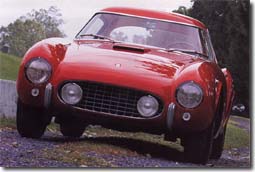 F rom 1955 on, this chassis was to become the 508 series with B,C,D and G suffixes to denote further minor modifications. Dimensions were 2600 mm for the wheelbase with front track of 1354 mm and rear track of 1349 mm which, until the advent of the Short-wheelbase Berlinetta of 1959, would remain static. Basically consisting of two parallel oval tubes which varied in thickness, this chassis comprised a cross tube at the front which supported the radiator and front suspension, a steel front bulkhead with, in the cockpit area, an "X" bracing of reinforcing tubes with two more cross tubes, one bisecting the "X" brace and one at the rear of the cockpit which supported the rear radius arm mountings. Two more cross tubes followed to stiffen the structure where the two main tubes swept up and over the rear suspension. The suspension consisted of one single leaf spring per side, Houdaille lever arm dampers and two radius arms, one above and one below the axle, which had an alloy center section and a limited-slip differential.
F rom 1955 on, this chassis was to become the 508 series with B,C,D and G suffixes to denote further minor modifications. Dimensions were 2600 mm for the wheelbase with front track of 1354 mm and rear track of 1349 mm which, until the advent of the Short-wheelbase Berlinetta of 1959, would remain static. Basically consisting of two parallel oval tubes which varied in thickness, this chassis comprised a cross tube at the front which supported the radiator and front suspension, a steel front bulkhead with, in the cockpit area, an "X" bracing of reinforcing tubes with two more cross tubes, one bisecting the "X" brace and one at the rear of the cockpit which supported the rear radius arm mountings. Two more cross tubes followed to stiffen the structure where the two main tubes swept up and over the rear suspension. The suspension consisted of one single leaf spring per side, Houdaille lever arm dampers and two radius arms, one above and one below the axle, which had an alloy center section and a limited-slip differential. 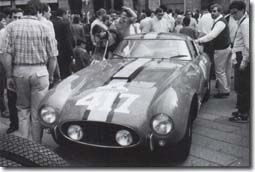 M ay 1956 saw the birth of I 0503 GT, an I V aluminum, Scaglietti-bodied Berlinetta with the first Tipo 128 motor, which was sold to A. Caraceni for Olivier Gendebien to drive in the Tour of Sicily where he and his co-driver/navigator/cousin, Jacques Wascher, won the GT class and came in 4th overall. Gendebien followed this up with another victory in the GT class, this time in the Mille Miglia where he and Wascher came home 5th overall. It is reported that Gendebien spun in this very wet event no fewer than five times.
M ay 1956 saw the birth of I 0503 GT, an I V aluminum, Scaglietti-bodied Berlinetta with the first Tipo 128 motor, which was sold to A. Caraceni for Olivier Gendebien to drive in the Tour of Sicily where he and his co-driver/navigator/cousin, Jacques Wascher, won the GT class and came in 4th overall. Gendebien followed this up with another victory in the GT class, this time in the Mille Miglia where he and Wascher came home 5th overall. It is reported that Gendebien spun in this very wet event no fewer than five times. 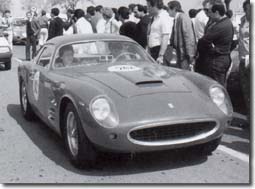 N ineteen fifty-eight saw 0707 GT and Michel Ringoir undertaking a very full season, starting in February, when he won the Routes du Nord Rally and then took part in such diverse events as the Cote D'Hoyet (hillclimb), Pau 3-hours (eighth overall, a street race) and the Cote D'Andenne (1st in GT, hillclimb). The Tour de France was entered once more but 0707 GT again failed to finish. 1959 saw just one event entered, again the Tour de France, but this time Ringoir did not start, having lost all his assets when the Belgian Congo lapsed into civil war.
N ineteen fifty-eight saw 0707 GT and Michel Ringoir undertaking a very full season, starting in February, when he won the Routes du Nord Rally and then took part in such diverse events as the Cote D'Hoyet (hillclimb), Pau 3-hours (eighth overall, a street race) and the Cote D'Andenne (1st in GT, hillclimb). The Tour de France was entered once more but 0707 GT again failed to finish. 1959 saw just one event entered, again the Tour de France, but this time Ringoir did not start, having lost all his assets when the Belgian Congo lapsed into civil war. Want more information? Search the web!
Search The Auto Channel!